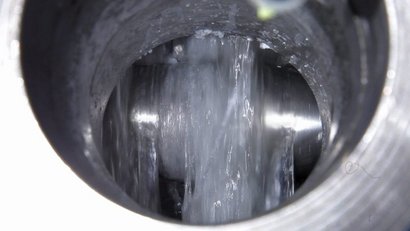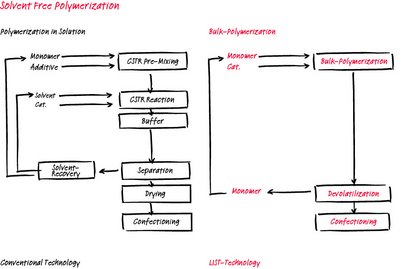本体聚合工艺
大多数聚合方法的目标是产生具有特定结构的高分子量材料。然而,这些聚合工艺过程通常又都是放热反应,并且其最终产品的粘度通常都非常高。传统的聚合物生产过程中为了吸收反应放热和将聚合后的物料稀释至较低的粘度以便于处理,需要引入大量的溶剂与(或) 过量的原料单体。利斯特捏合反应器能够在处理极高粘度的物料的同时,为系统输入或移除极大量的热量。利斯特捏合反应器的上述特性使其成为替代传统工艺及设备的理想选项。
采用利斯特捏合反应器的典型工艺过程通常包括两个操作单元:
在第一个操作单元中,无溶剂的条件下的高浓度单体与引发剂在利斯特捏合反应器中开始聚合反应,某些体系的反应转化率可达到 90%,个别物系可进一步提升至99%。
在聚合单元之后的第二个操作单元中,聚合之后的物料在利斯特捏合反应器中直接脱除溶剂或未反应的单体等挥发性组分,挥发性组分的残留量可低至1000ppm甚至更低。
特别是在放热的本体自(共)聚反应工艺中,利斯特捏合反应器巨大的换热面积与蒸发冷却这一技术手段相结合,非常有利于精确控制物料温度。搅拌部件的独特几何形状可以提供持续的表面更新和优化传热,并最大限度地减少产品积聚和死区的出现。
我们的优势
- 高效的自清洁作用能够最大限度的减少死区的产生、物料的累积以及降解等现象;
- 优异的捏合及混合作用利于物料体系均匀同质化;
- 较低的过程剪切力;
- 高效的能量传递;
- 较高的表面更新率;
- 较大的汽相自由扩散空间;
- 较大的传热面积,利于准确及均一化的温度控制;
- 工艺过程可设计为连续化操作;
- 适合黏稠或高粘度物系的工艺需求;
- 较宽且可灵活调整的平均停留时间区间;
- (反混设计)可使停留时间灵活满足工艺需求;
- 从实验到工业装置的工程放大可靠且低风险;
- 过程转化率较高;
- 聚合物分散指数(PDI)可达2~2.5之间;
- 反应过程可在近似精确计量条件下进行;
工业应用实例
聚甲基丙烯酸甲酯 (PMMA)
在利斯特捏合反应器中进行的甲基丙烯酸甲酯本体聚合的反应转化率可以达到 98%,聚合物分散指数(PDI)可达到2.0至2.5之间。
高吸水性树脂 (SAP)
丙烯酸在其水和溶液中进行本体聚合时,反应终止时聚合物含量可达45%,反应转化率可高于99%。利斯特捏合反应器中精确的温度控制非常利于将分子链分布(PDI)控制在较窄的区间。由于采用了特殊的机械设计形式,高吸水树脂物料可以粒料的形式从反应器中直接排出。
相关资料下载
| 标题 | 描述 | 语言 | 发表时间 | 下载 |
|---|---|---|---|---|
| Reactor for solvent-free polymer processing | Converting the polymer industry to solvent-free polymerisation processes and avoiding unnecessary recirculation decreases energy consumption and reduces waste production. This can be achieved with the horizontal large-volume Kneader Reactor with superior mixing and homogenisation performance. The casing, shafts and mixing elements are indirectly heated by heat transfer fluids and dynamically self-cleaning. | English | 2012 | |
| Ganz ohne Lösungsmittel – Syntheseverfahren in der konzentrierten Phase | Mit lösemittelfreier Prozessführung, dem sogenannten Dry Processing, lassen sich zwei entscheidende Ziele erreichen: umweltfreundliche Prozesse und eine deutliche Senkung der Investitions- und Betriebskosten. Die Schweizer Firma List konzentriert sich dabei nicht auf einzelne Verfahrensschritte, sondern auf den Prozess als Einheit, um eine ganzheitliche verfahrenstechnische und wirtschaftliche Optimierung zu erreichen. | Deutsch | 2009 | |
| Es geht auch ohne Lösungsmittel | Sie suchen ein lösungsmittelfreies, sicheres, umweltfreundliches und energieeffizientes Herstellungsverfahren, das neue Produkttypen mit neuen Qualitätsmerkmalen hervorbringt? Eine neue Technologie macht’s möglich. | Deutsch | 2009 | |
| Saying goodbye to solvents | Are you looking for a solvent-free, safe, eco-friendly and energy-efficient way of producing new types of products with new levels of quality? New technology is available to help you do exactly that. | English | 2009 | |
| Prediction of Kneader Reactor Bulk Co-Polymerization Continuous Processes | Batch trials were performed on a kneader reactor where a bulk co-polymerization was carried out. Polymerization conversion, viscosity build, reaction kinetics, and heat transfer calculations were performed using the experimental data from the batch trials. A continuous process was proposed for this bulk copolymerization and the models and results from the batch trials were used in designing the continuous process. Predictions of the continuous process using the batch trial data are compared to the actual continuous process, with a focus on polymer conversion, heat transfer, and torque prediction. | English | 2007 | |
| Bulk Polymerisation or Copolymerisation in a Novel Continuous Kneader Reactor | A new type of kneader reactor is proposed for the continuous radical (co-) polymerisation without solvent, based on the proven design of mature (kneader-) dryer technology. The reactor has been developed to satisfy all major aspects required for (co-) polymerisation while maintaining the safety and reliability of the previous mechanical design. The new kneader reactor offers a perfect combination of surface renewal and evaporative cooling to control temperature to high conversion (85 to 95%), even for bulk systems that have a strong gel effect (Trommsdorff’s effect) and high exothermicity. | English | 2006 | |
| Bulk polymerisation of MMA in a kneader reactor | The bulk free radical polymerization of methyl methacrylate (MMA) or the bulk free radical copolymerization of MMA based monomer recipes face a gel effect (Trommsdorff’s effect) and exothermicity. The kneader reactor offers a perfect combination of surface renewal and evaporative cooling to control temperature at high conversion (85 to 95%). | English | 2006 | |
| Continous polymerisation | Various types of reactor have been developed to date for improving the stability of the polymerisation process. This review describes a few examples of heterogeneous and homogeneous polymerisation, focusing particularly on viscosity control and heat removal. The production of solid polymer granules directly in a kneader-reactor with evaporative cooling is one efficient and reliable polymerisation technology. | English | 2003 | |
| CKR for continous polymerisations producing solid granular polymers | A review of the existing polymerisation processes is proposed, with particular attention to the control of viscosity and heat removal. Up to the present time, different types of reactor have been developed in order to improve the stability of the polymerisation process. A review of these reactors is presented for the heterogeneous and homogeneous polymerisations. The production of solid polymer granules directly in a kneader reactor under evaporative cooling is seen as an efficient and reliable polymerisation technology. | English | 2001 |


